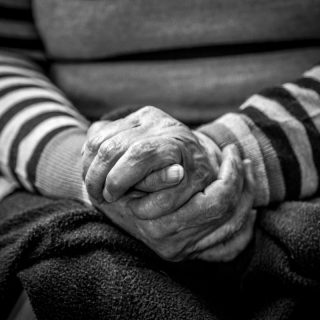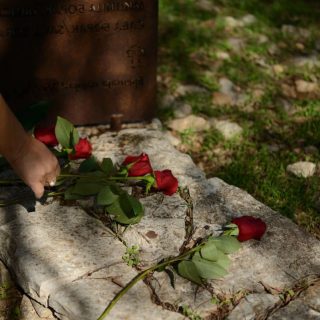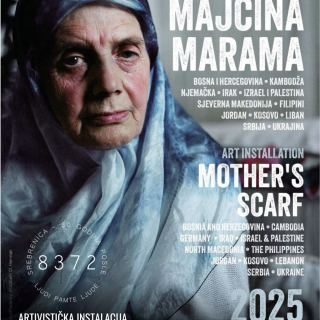On 28 April this year, a group of delegations from the Veterans’ Committee, the Ministry of Defence, the Army, the Ministry of Interior, and several political parties commemorated the killing of eight members of the security forces that occurred in 2001 between the villages of Selce and Vejce on Shar Planina. After the event, the delegations picked up the board with the names and photos of those killed near Vejce, took it with them, and sent a message for protection of the memorials, which, in previous years, were demolished just a few hours after being erected. This event is just one of the numerous similar cases of associating a specific location with the ethnic or religious group that inhabits that area, and, with it, the exclusive right to places of remembrance, ritual celebrations, and the erection of symbols. All studies of memory activities related to 2001 in present-day North Macedonia confirm this dynamic, and there are almost no cases that suggest a reexamination or overcoming of this logic. The situation is the same in the capital, Skopje, where symbols of memory – such as monuments and street and neighbourhood names, for example – and performances – such as public commemorations and festivals – were, and still are, used to mark space and create symbolic and physical boundaries between different ethnic and religious groups.
Although these types of events related to the memories of 2001 are not necessarily perceived as violent acts against people by the authorities and public social actors (and, unfortunately, there have been several such incidents over the past two decades), in theory, attacks on memorials are treated as a special type of violence, that is, as part of the so-called commemorative-related violence. This analytical concept was first promoted in Northern Ireland during the 2000s, as an attempt to understand the acts of aggression that accompany a commemorative event, including attacks on monuments and murals and, in particular, the escalation of public commemorative processions. Since then, several authors have interpreted this phenomenon in different ways: as attempts to publicly display the culture of violence, which is usually associated with the history of local conflicts, but also as a way to delegitimize the peace process in the given context. According to these views, commemorative events are interpreted as a scene that contributes to manifesting togetherness and group cohesion, but also radicalization through the articulation of hate messages.
The Balkans, unfortunately, also abound with cases of escalation of public commemorations, whether as events that result in violence by participants, as events that provoke violence by other groups, and as events that are followed by acts of demolition of memorials. One of the most illustrative research projects in this context, FRAMNAT, analysed seven commemorative events in Croatia related to World War II and the Yugoslav Wars of the 1990s. In relation to our topic, the project researchers found that the use of militant discourse by, mainly, political elites during commemorative events leads to a process of voter mobilization through the recreation of some war tropes and ramifications. There are many other similar cases of violence related to public commemorations, where different ethnic and religious groups play the roles of victims and aggressors. Without going too far, a common place is the contested celebrations of ethnic Macedonians in Greece and Bulgaria, but also the violence by Macedonians – symbolic and physical – against certain places of remembrance tied to different ethnic or political connotations, as is the case with the commemoration of Mara Buneva in Skopje, almost every January since 2001.
Considering this position, within the framework of the research project CONNEKT: Contexts of Violent Extremism in MENA and Balkan Societies, we tried to understand how commemorative events related to the 2001 conflict affect young people in North Macedonia; more precisely, in terms of their perceptions of the past, of interethnic relations in the country, but also of the 2001 conflict and the post-conflict political and social dynamics. We focused on Tetovo, as a city that was on the front line at the beginning of the conflict and in whose immediate vicinity some of the most tragic episodes related to the conflict took place. Moreover, some of the key commemorative events related to 2001 are being held in Tetovo and the Tetovo region, on both sides of the conflict: on the one hand, the deaths of members of the security forces near Vejce, Karpalak, Chelopek, Ratae, Gajre and at the Tetovo fortress, and on the other hand, the commemorations of the beginning of the armed conflict by veterans of the NLA and DUI in Shemshevo, as well as the commemoration of the Albanian civilian victims in Dzepchishte and Poroj. In 2005, in the village of Selce, Tetovo, a memorial complex dedicated to the 112th Brigade “Mujadin Aliu” of the NLA was opened.
Without any intention to relativize the historical facts related to 2001, our research idea was to talk to young people from both ethnic communities, in a focus group format, in order to gain insight into how commemorative events, and especially the violence associated with public commemorations, affect their perceptions and worldviews. The four focus groups were organized in February 2022, with a generation of Tetovo residents born after 2001: two with Macedonian and two with Albanian youth groups. As a summary and in short, some of the key conclusions related to perceptions of 2001. Young people from both ethnic groups almost unanimously condemn the escalation of 2001 and perceive it as anachronistic, characteristic of other, older generations – a perception that can be recapitulated with the slogan “we should not live in the past.” These perceptions of the armed conflict are particularly interesting from the perspective of the potential for peaceful interethnic cooperation and coexistence. Thus, the condemnation of 2001 in this case functions as bridging capital that could enable a better future based precisely on the lack of direct memories of the events of 2001. Similar studies dedicated to other cities in the country come to similar conclusions: in Kumanovo, for example, young people aged 15 to 35 have greater bridging capital than older generations due to the absence of direct memories of the Yugoslav Wars and the 2001 conflict in Macedonia.
However, the focus groups helped us perceive some different interpretations related to 2001: the violence related to public commemorations is exclusively interpreted from an ethnic perspective, with a tendency to blame the “other” – the other ethnic or religious group – for all instances of violent behaviour, provocation and demolition. Although, again, there is a similar observation that small groups are behind the violence related to commemorative events, there is also a strong prejudice that the history of one’s ethnic group is not sufficiently understood by fellow citizens from other ethnic and religious groups. Nevertheless, two focus groups showed that the two groups of youth recognize different reasons behind these escalations: thus, according to the Albanian youth, these differences are the result of economic and political discrepancies, while the Macedonian youth pointed to identity issues as key to the different interpretations. In conclusion, despite the similar optics of the conflict and the way in which violence is fuelled by public commemorations, the gap between the two groups appears as soon as the broader context is obscured, which, in turn, poses a serious danger to the bridging capital of young people.




